o yis Postpositions
Frames of reference
The Istran languages use a mixture of absolute, intrinsic and relative frames of reference for describing the location and orientation of objects in relationship to each other, and to the speaker. Unlike languages - such as Ramajal - where the relative frame of reference (left, right, ahead, behind) predominates, O Yis speakers make heavy use of an absolute frame of reference (northwards, southwards, eastwards, westwards) for much of the work of locating objects; maintaining an internal compass is an integral part of speaking the language.
The relative frame of reference is restricted, in the horizontal plane, to objects that are within touching (or spitting) distance. Vertical frames of reference, however, are relative to the height of the speaker's eyes (above, below), or are intrinsic to an object (on top of, beneath).
The intrinsic frame of reference further assumes that most immobile objects face south, and thus have their backs facing north; for those objects that have an obvious main entrance, that side is considered to be the front of the object while the opposite side is referenced as the back.
The origins of postpositions
Almost all O Yis postpositions can trace their origins back to complete words: the four anchors of the absolute reference system are derived from the words for ice (northwards), morning (eastwards), warm water (south) and evening (west) - given the history of the Istran Society as seafarers who spent as much time on the water as they did on land, the choice of references can be understood.
The origins of the postpositions for above (skywards) and below (seawards) are equally obvious. Less obviously, almost all Istran languages employ a vertical metaphor to represent the passage of time: the sky represents the future while the sea represents the past. O Yis speakers view time as equivalent to light, sinking from the bright sky to the dark ocean depths. Movement and location through the temporal plane is assumed to be relative to the now, unless a different point in the time-stream is indicated by the speaker.
A range of postpositions have also developed from the words for various body parts; these include the nose (for 'the front of'), tail (the rear of), face (opposite), eyes (in front of), rear (behind), heart (inside), belly (acquisitive), hands (benefactive, instrumental), fingers (measurement and accompaniament), and thumbs - from which arose the passive marker. The wind indicates that which is outside or beyond, while the breath lies on the cusp of internal and external: that which touches.
Motive and spatial postpositions
When describing place or motion, an O Yis speaker will generally include information on the absolute direction of movement or position (north, south, east, west) in addition to relative details (at, near, by, towards, away from, along):
- iT itz - at, beside, near, north of
- ipjam ipjam - at, beside, near, east of
- il il - at, beside, near, south of
- icven icven - at, beside, near, west of
- iTjid itzjid - north to, towards
- ipjamid ipjamid - east to, towards
- illid illid - south to, towards
- icveNid icveŋid - west to, towards
- iTjer itzjer - north from
- ipjamer ipjamer - east from
- iller iller - south from
- icveNer icveŋer - west from
- iDblez idzblez - north along, by, via
- ipjamblez ipjamblez - east along, by, via
- ibez ibez - west along, by, via
- icvebez icvebez - south along, by, via
- ix ix - at, on, touching
- itoT itotz - above, over
- izaurz izaurz - below, under
- ihuTjid ihutzjid - out of
- jabjid jabjid - into
Examples
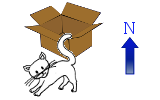
- Xhata feeta in maav ni jafig il
- hata féta in máv ni jafig il
- hætæ fəˑtæ in mæˑw ni jæfig il
- the cat is playing in front of (south of) the box
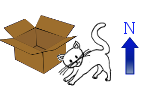
- Xhata feeta in maav ni jafig ipjam
- hata féta in máv ni jafig ipjam
- hætæ fəˑtæ in mæˑw ni jæfig ipjæm
- the cat is playing next to (east of) the box
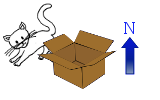
- Xhata feeta in maav ni jafig icven
- hata féta in máv ni jafig icven
- hætæ fəˑtæ in mæˑw ni jæfig iswən
- the cat is playing by (west of) the box
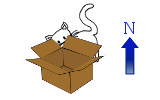
- Xhata feeta in maav ni jafig iT
- hata féta in máv ni jafig itz
- hætæ fəˑtæ in mæˑw ni jæfig iʧ
- the cat is playing behind (north of) the box
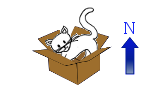
- Xhata feeta in maav ni jafig ix
- hata féta in máv ni jafig ix
- hætæ fəˑtæ in mæˑw ni jæfig ix
- the cat is playing in (at/on) the box
As can be seen, the 'at/near' postpositions are the default forms, with movement towards, away from or along an object modifying those defaults. While the directional postpositions are always used when motion between two objects is being described, the 'at/near' postpositions are only used between two movable objects. When one of the objects is immovable, and can thus be used as the base for intrinsic references, a second set of postpositions is used.
For an immovable object, where the object has no obvious entrance:
- ifuiD ifuidz - north of
- idem idem - south of
For an immovable object with an obvious entrance:
- itvim itvim - the back of
- ifjaf ifjaf - the front of
For the movable object:
- ibvad ibvad - behind, at the rear of
- ivoal ivoal - ahead of, at the front of
- itosjid itosjid - up to, below
- izaurzjid izaurzjid - down to, above
For any of the objects:
- icper icper - opposite, across from, facing
- iblez iblez - to the side of, beside
- itoxol itoxol - on, on top of, resting on, touching
- ihuT ihutz - outside, surrounding
- jab jab - in, inside, surrounded by
Temporal postpositions
There are a number of methods for ordering events within a time frame, of which the temporal postpositions are just one facet: other methods include nominal and verbal temporal quantifiers, verb articles, verb auxillaries and time-related noun phrases.
- itojid itojid - a long time before, approaching
- ito ito - before, forthcoming
- ixol ixol - during, at
- izau izau - after, preceding
- izaujid izaujid - afterwards, a long time after
Grammatical postpositions
A final group of postpositions play a role in building noun and verb phrases, and clauses. This group includes words that in other languages could be thought of as conjunctions (such as 'and' and 'or'):
- Di dzi - of, for (measuring)
- igly igly - for (acquire)
- irt irt - for (direct benefit)
- rette rette - for (situational benefit)
- ijer, jer ijer, jer - from (partitive)
- itau, tau itau, tau - concerning, by
- irat, rat irat, rat - with, using
- iDim, Dim idzim, dzim - and, with, accompanied by
- iqer, qer iqer, qer - or, alternatively
- ibek, bek ibek, bek - like
Where there are alternate forms of the postposition, the i- form is used to coordinate (list) nouns while the short form is used for coordinating other parts of speech (such as verbs and quantifiers).